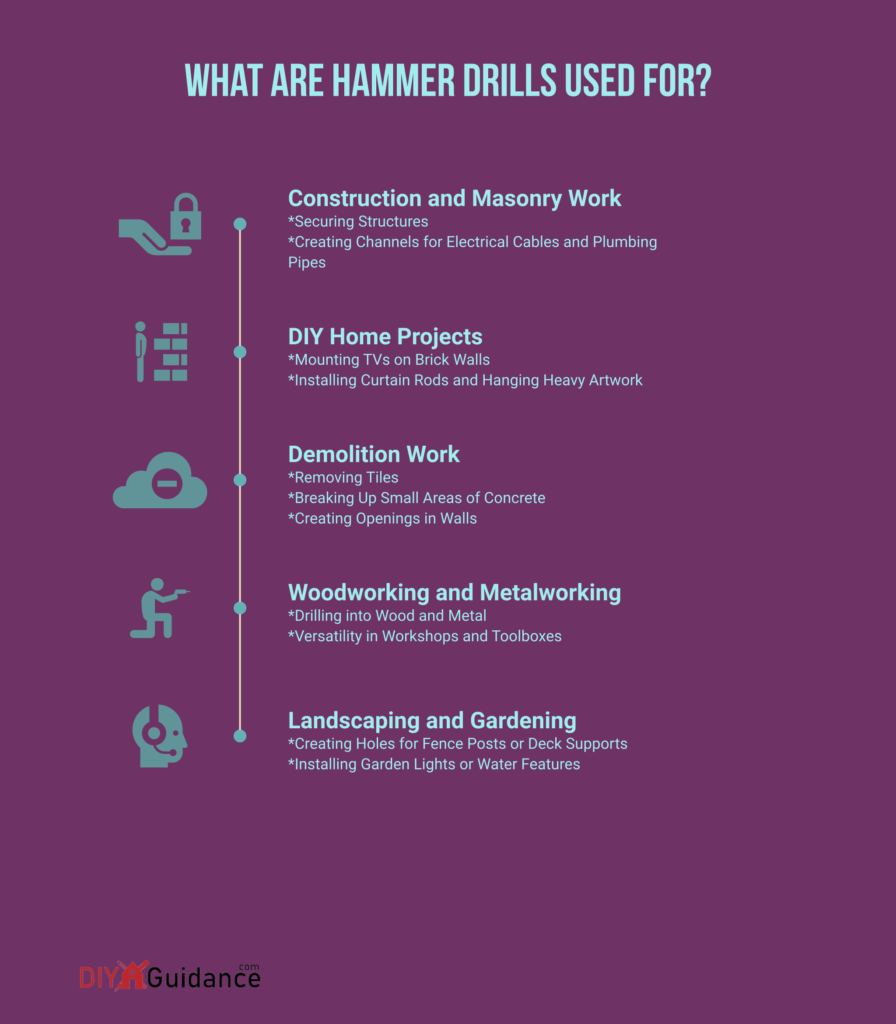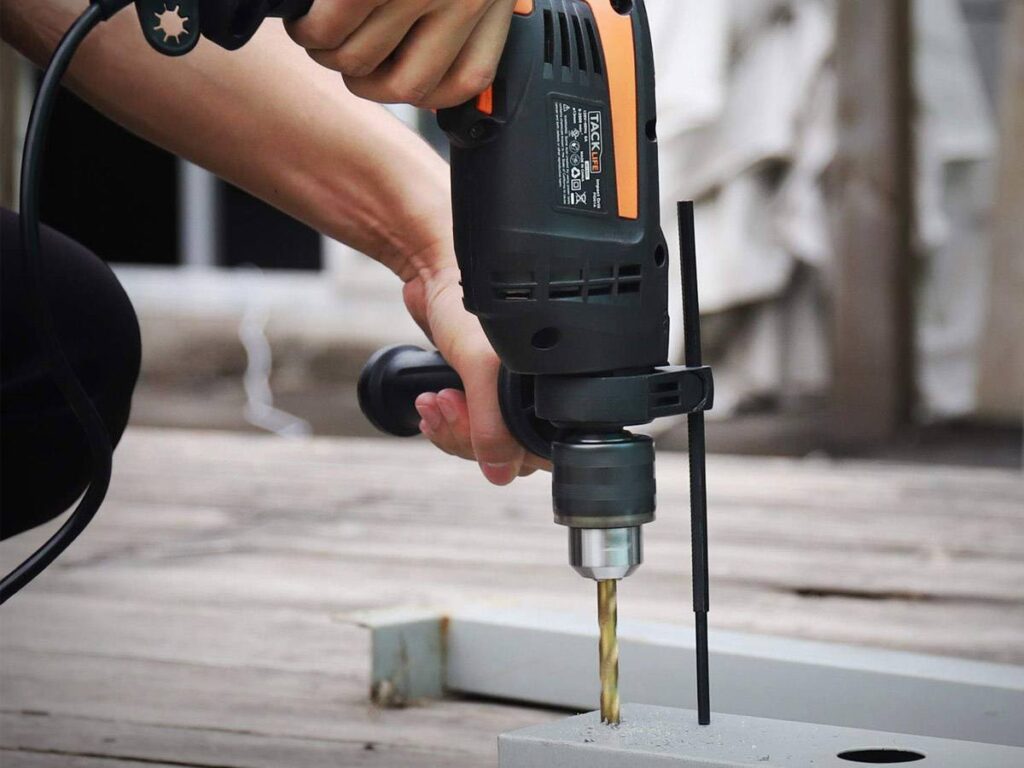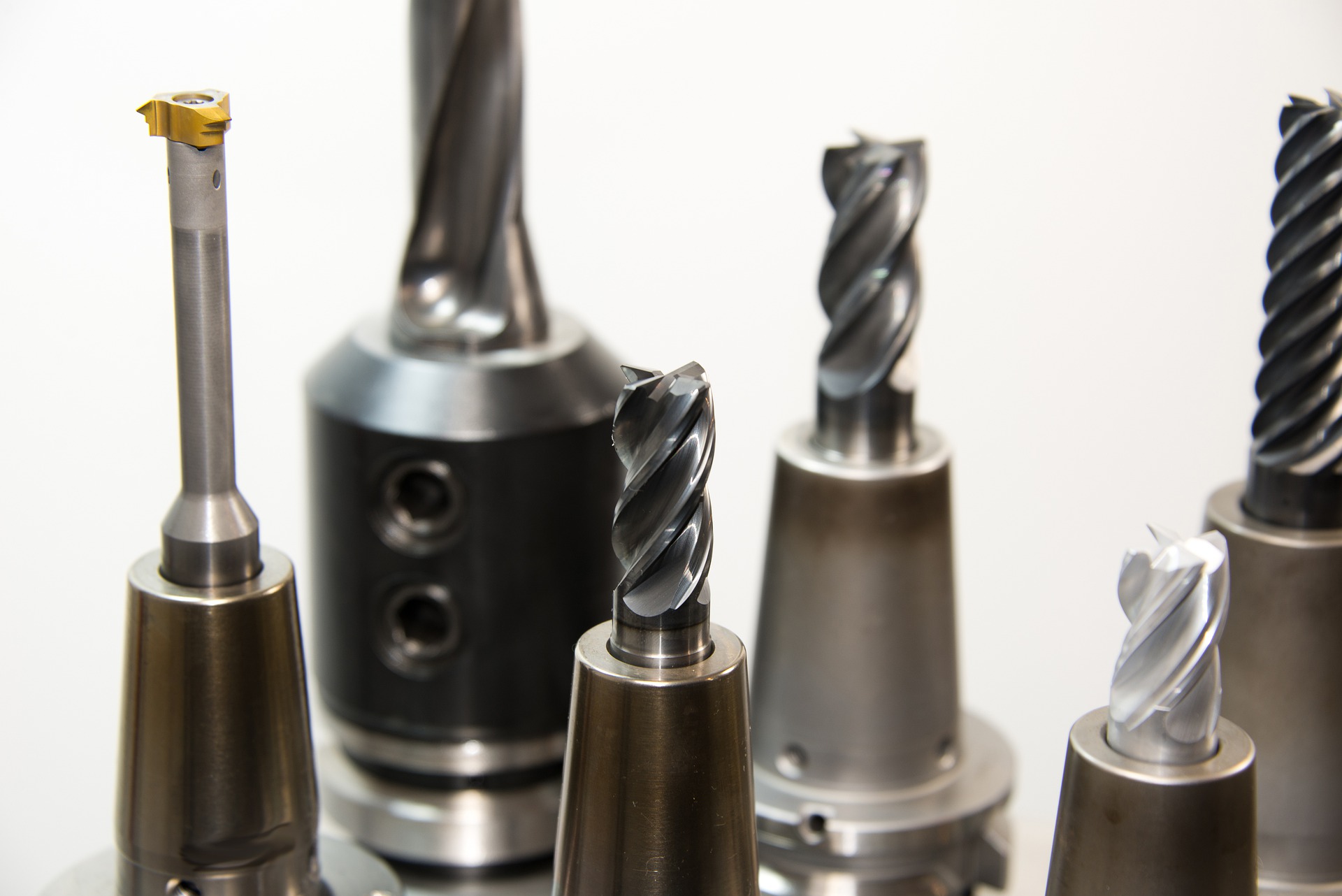Have you ever struggled to drill through tough materials like concrete, brick, or stone? If so, you’re not alone. That’s where hammer drills come in handy. These powerful and versatile tools combine the functionality of a standard drill with a hammering action, making it much easier to tackle those challenging drilling tasks. Do you have any idea what are hammer drills used for?
As someone who’s used hammer drills in various projects, I can attest to their importance across different industries, such as construction, masonry, woodworking, and even DIY home projects.
In this article, we’ll explore the top uses and applications of hammer drills, sharing some personal insights on how they’ve significantly impacted my work and could potentially benefit yours too.

Construction and Masonry Work
Regarding construction and masonry work, hammer drills have proven to be a game changer. Their easy ability to drill through hard materials makes them an indispensable tool in these industries. Let’s take a closer look at some specific tasks where hammer drills are useful and how they can make your life easier on the job site.
✔Securing Structures: Anchors, Dowels, and Concrete Screws
In construction projects, securing structures using anchors, dowels, and concrete screws is crucial. However, drilling holes for these fasteners in materials like concrete, brick, or stone can be extremely challenging using a regular drill. That’s where hammer drills make a world of difference.
With their hammering action, corded hammer drills significantly reduce the time and effort required to create precise holes for anchors, dowels, and concrete screws.
For example, when working on a project that requires attaching metal brackets to a concrete wall, you can quickly and efficiently drill the necessary holes using a hammer. It saves you time and ensures a secure connection between the wall and the brackets.
✔Creating Channels for Electrical Cables and Plumbing Pipes
Another common task in construction and masonry work is creating channels in walls or floors for running electrical cables or plumbing pipes. It can be particularly challenging when dealing with solid materials like concrete and brick. Once again, hammer drills come to the rescue!
I remember working on a renovation project where we needed to run new electrical cables through a brick wall. Using a rotary hammer drill, we created the necessary channels without causing excessive damage to the wall or spending hours chipping away at the brick with a chisel and hammer. The hammer drill’s powerful impact made quick work of the task, allowing us to focus on other aspects of the project.
The hammer drill’s unique capabilities in both examples proved invaluable in construction and masonry work. By making tough drilling tasks more manageable and efficient, it’s no wonder that hammer drills have become a staple tool in these industries.
DIY Home Projects
Regarding home improvement, there’s something incredibly satisfying about completing a project on your own. As a fellow DIY enthusiast, I’ve found that having a hammer drill in my toolbox has made tackling various tasks around the house more manageable and enjoyable.
Let’s explore specific examples of how a hammer drill can empower your creativity and make your DIY home projects successful.
✔Mounting TVs on Brick Walls
One project I’m particularly proud of is mounting a flat-screen TV on a brick wall in my living room. While drilling into brick may seem intimidating, hammer drilling made the task a breeze. The tool’s hammering action will allow you to create precise holes without the bit slipping or struggling, which is often the case with regular drills.
With the right masonry bit and a steady hand, you can securely mount the TV bracket on the wall, ensuring a safe and sturdy setup for your family to enjoy our home theater experience. The hammer drill made drilling into brick feel effortless, turning what could have been a challenging project into a seamless endeavor.
✔Installing Curtain Rods and Hanging Heavy Artwork
Another area where a hammer drill can significantly impact any DIY home project is when installing curtain rods or hanging heavy artwork. Using a hammer drill for concrete or brick can be challenging when hanging curtains or large frames, but it simplifies these tasks.
For instance, when installing a curtain rod in your bedroom with concrete walls, a regular drill wouldn’t be sufficient. Using a corded drill, you can quickly and accurately create the necessary holes for the rod brackets, allowing you to hang your curtains without any complications.
Similarly, the hammer drill can be your go-to tool when you want to hang a large, heavy painting on a brick wall in your living room. It will allow you to drill the holes for the mounting hardware precisely and easily, ensuring your artwork is securely hung and perfectly level.
The hammer drill’s ability to handle tough materials can make any DIY home project enjoyable and stress-free. By removing the barriers associated with drilling into concrete, brick, or stone, a hammer drill empowers you to beautify your living space confidently.
Demolition Work

Hammer drills are versatile tools anyone can use for various tasks, from drilling holes in concrete to breaking up materials for demolition work.
✔Removing Tiles
One of the most common uses for hammer drills in demolition work is removing tiles from floors and walls. When equipped with the appropriate chisel attachment, a hammer drill can quickly work this task, saving time and effort compared to manual methods.
Here’s how you can do it:
- First, set the hammer drill to the chiseling or hammer-only mode.
- Position the chisel at a low angle against the edge of a tile, ideally at a grout line, to minimize potential damage to the underlying surface.
- Apply gentle pressure and let the hammer drill work, breaking the tile away from the surface.
- Continue working methodically across the surface, removing one tile at a time.
For larger projects or when removing multiple layers of tiles, consider using a wider chisel attachment to increase efficiency.
✔Breaking Up Small Areas of Concrete
You can also use hammer drills to break up small concrete areas like sidewalks, patios, or driveways. It can be especially useful for making targeted repairs or preparing an area for new construction.
Follow these steps for successful concrete demolition:
- Equip your hammer drill with a pointed chisel or bull point bit designed specifically for breaking up concrete.
- Mark the area you wish to break up, ensuring you have a clear plan for your work.
- Position the bit at a slight angle and apply pressure as you engage the hammer function.
- Work in a systematic pattern, breaking up the concrete into manageable pieces.
Remember to wear appropriate safety gear, such as eye protection, gloves, and earplugs, as concrete demolition can produce flying debris and loud noise.
✔Creating Openings in Walls
Whether for installing new windows or doors or simply creating access points for utilities, hammer drills can be a valuable tool for creating openings in walls made of brick, concrete, or other masonry materials.
Here’s how to create a precise opening using a hammer drill:
- Measure and mark the dimensions of the desired opening on the wall, ensuring accuracy and proper alignment.
- Drill holes along the marked lines using a masonry bit, spacing them close together for easier removal.
- Switch to a chisel attachment and set the hammer drill to chiseling mode.
- Carefully chisel along the drilled holes, breaking away the material within the marked area.
- Clean up the edges of the opening with a cold chisel or an angle grinder fitted with a masonry disc.
By following these steps, you can create clean and precise wall openings with minimal effort and without needing more specialized equipment.
Woodworking and Metalworking
While hammer drills are often associated with masonry and concrete work, they can also be valuable tools for woodworking and metalworking projects. With the right attachments and techniques, a hammer drill can be a versatile addition to your workshop or toolbox.
✔Drilling into Wood and Metal
Hammer drills can easily transition from heavy-duty masonry work to precise woodworking and metalworking tasks by switching out the appropriate bits and turning off the hammer function.
Here’s how you can use a hammer drill for drilling into wood and metal:
- Ensure that you turn off the hammer function, as it is not necessary for these materials and can cause damage.
- Choose the appropriate bit for your material: For wood, use a wood-boring bit such as a spade, auger, or Forstner bit. For metal, use high-speed steel (HSS) or cobalt bit designed for drilling metal.
- Adjust the drill’s speed setting if applicable, opting for a lower speed for metal and a higher speed for wood.
- Mark the desired drilling location on the material, ensuring accuracy and proper alignment.
- Begin drilling, applying steady pressure while maintaining control of the drill to ensure clean, precise holes.
Following these steps, you can effectively use a hammer drill for woodworking and metalworking projects, making it an adaptable tool.
✔Versatility in Workshops and Toolboxes
The ability to use a hammer drill for various tasks, including woodworking, metalworking, and masonry, makes it an incredibly versatile tool that can save space and money in your workshop or toolbox.
Here are some benefits of having a hammer drill as part of your collection:
- All-in-one functionality: With the appropriate bits and attachments, a hammer drill can replace several specialized tools, such as a dedicated wood drill, metal drill, and masonry drill.
- Space-saving: By owning a single tool that can handle multiple tasks, you can minimize the number of tools you need to store, freeing up valuable space in your workshop or toolbox.
- Cost-effective: Investing in a high-quality hammer drill can save you money in the long run, as you won’t need to purchase separate tools for different materials and tasks.
- Adaptability: A hammer drill’s versatility allows you to easily tackle a wide range of projects, from furniture assembly and cabinetry work to metal fabrication and concrete repairs.
Landscaping and Gardening

Hammer drills are useful for construction and woodworking tasks and can also play a vital role in landscaping and gardening projects. Their power and versatility make them ideal tools for working with various materials and executing precise work in outdoor settings.
✔Creating Holes for Fence Posts or Deck Supports
When installing fence posts or deck supports, it is crucial to create sturdy, deep holes to ensure the stability of your structure. A hammer drill can make this process efficient and precise, particularly when working with hard or rocky ground.
Here’s how to use a hammer drill for this purpose:
- Choose the appropriate bit for the job. For drilling into soil or clay, use an auger bit. For rocky or compacted ground, use a masonry bit.
- Mark the desired location for each hole, ensuring proper spacing and alignment according to your project’s specifications.
- Set the hammer drill to the appropriate mode: Use the hammer function for rocky ground or switch to regular drilling mode for softer ground.
- Begin drilling, applying steady pressure to create clean, consistent holes to the required depth.
- Once the holes are drilled, insert the fence posts or deck supports and secure them with concrete or appropriate materials.
Following these steps, a hammer drill can create sturdy foundations for your outdoor structures.
✔Installing Garden Lights or Water Features
Garden lights and water features can significantly enhance your outdoor spaces’ ambiance and aesthetic appeal. A hammer drill can make the installation more manageable, especially when working with hard or uneven surfaces.
Here’s how to use a hammer drill to install these features:
- Determine the location for your garden lights or water feature, considering factors such as access to power sources and water supply.
- If drilling into concrete or stone surfaces, equip your hammer drill with a masonry bit of the appropriate size; for wood or other materials, use a suitable bit and switch off the hammer function.
- Mark the drilling locations for mounting brackets, electrical conduits, or plumbing fixtures, ensuring proper alignment and spacing.
- Drill the necessary holes, apply steady pressure, and maintain drill control for precise results.
- Install the garden lights or water features according to the manufacturer’s instructions, securing them with the appropriate hardware.
Using a hammer drill to create precise holes for mounting and installation, you can efficiently install garden lights and water features, transforming your outdoor spaces into a serene and inviting oasis.
Frequently Asked Questions
Q: What is the difference between hammers and regular drills?
A: Regarding power tools, many options are available for various tasks: saws, sanders, and drills, just to name a few. However, not all drills are created equal when drilling into tough materials like concrete or masonry. It is where the hammer drill comes in.
Unlike a regular drill, a hammer drill delivers an up-and-down pounding motion as it spins, allowing it to easily break through tough surfaces. An internal clutch creates this unique motion that slams the chuck forward as the drill bit spins, making it a must-have tool for any DIYer or contractor who needs to tackle tough drilling jobs.
Q: Can I use a hammer drill for regular drilling tasks?
A: If you own a hammer drill, you may wonder if using it for regular drilling tasks is appropriate. The answer depends on the type of drilling you want to do. Hammer drills are for drilling through hard materials like concrete or stone.
Using a hammer drill for regular drilling in softer materials like wood or plastic may be unnecessary and potentially damage the material. However, if you need to drill in both hard and soft materials, a hammer drill with a switch for regular drilling can be a versatile tool to have in your toolkit.
Q: What drill bits should I use with a hammer drill?
A: You’ll want to look for drill bits specifically designed for use with a hammer drill, as these typically have a heavier and more durable construction than regular drill bits. Some of the most common hammer drill bits include masonry bits, carbide-tipped bits, and diamond-tipped bits, each offering unique advantages.
By selecting the right drill bit for your hammer drill, you can maximize its performance and ensure you complete your drilling jobs quickly and efficiently.
Q: Do I need a hammer drill for all DIY projects?
A: No, a hammer drill is unnecessary for all DIY projects. When it comes to DIY projects, having the right tools is crucial to getting the job done right. And while a hammer drill can be useful in certain situations, it’s not always necessary for every project.
Before investing in a hammer drill, consider the projects you plan to undertake. A hammer drill will likely come in handy if you’ll be working with masonry, such as drilling into brick or concrete. However, a regular drill will suffice for simple tasks like hanging pictures or assembling furniture.
Final Thoughts
Hammer drills have proven to be an indispensable tool in various applications and industries. Throughout this discussion, we have explored some of the top uses and applications for these versatile devices, such as drilling into concrete, brick, and masonry, as well as their utility in woodworking and metalworking projects.
Furthermore, we have delved into how hammer drills have become a crucial instrument for professionals in construction, renovation, and even DIY enthusiasts, who rely on them for efficient and precise work. You can’t overstate the importance of hammer drills, as they have revolutionized how we approach various projects and tasks, making them more manageable and less time-consuming.
In essence, the ever-evolving world of hammer drills continues to impact how we work, creating new possibilities and paving the way for innovation in countless industries. As we move forward, it is clear that the role of hammer drills will only continue to grow, solidifying their place as an essential component in the toolbox of any professional or DIY enthusiast.
So, next time you struggle with a stubborn surface or dream up new ways to enhance your living space, remember that a trusty hammer drill is just the ally you need to bring your vision to life. Let me know in the comment section what projects you have used a hammer drill for. And don’t forget to always use the right tools and techniques to do the job safely.


